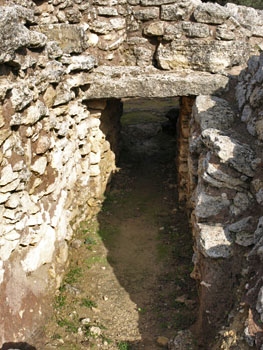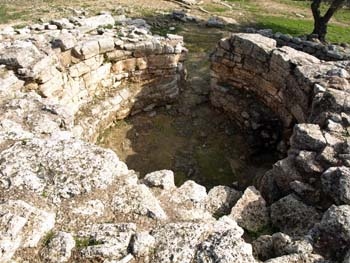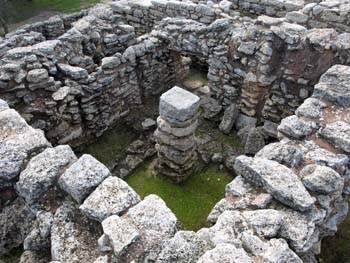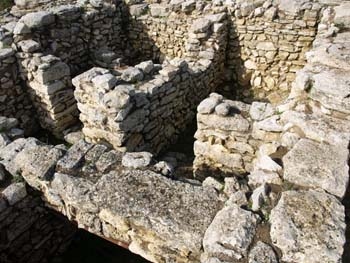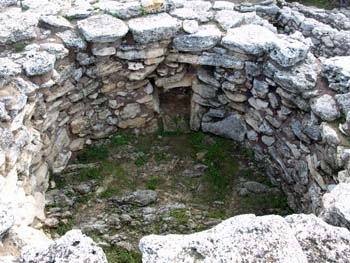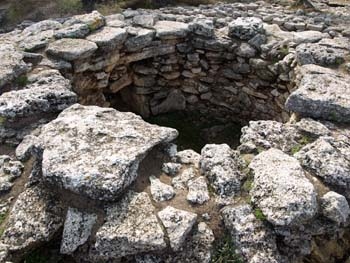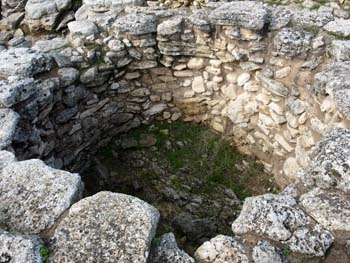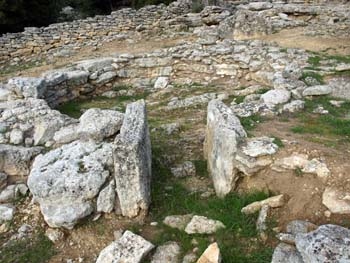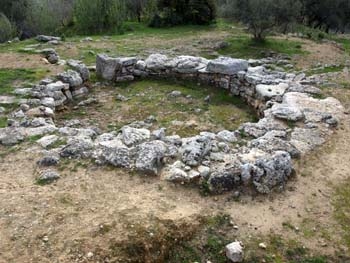Phourni
Tholos Tomb B
Continuing southwards through the cemetery we come to Tholos Tomb B. Tholos Tomb B was built before 2000 BCE at the end of the Early Bronze Age and was almost certainly used for the burial of people of royal descent up until LM IIIA so it remained in use for hundreds of years.
Although the Tholos Tomb B complex, which numbers 12 spaces, underwent modifications, especially during the early period of its existence, it was essentially a rectangular complex with the tholos tomb at its centre.
The dromos approaches the tholos from the south east and the tholos had two side chambers, one to the west and one to the east which no longer exists. At some point the floor of the tholos was raised and a bench was built around the tholos wall. At the same time an entrance into the eastern chamber was opened up. The entrance from the tholos and the entrance to the western chamber were blocked up.
The south west chamber seems to have been built around the larnax which it contained since it would not have been possible to manoeuvre the larnax into the chamber after it was built. The larnax was in fact an ossuary, containing the bones of 19 people, including two children. Most of the people had died below the age of 35.
Another chamber in the complex, south-east of the western chamber, is a pillar crypt, constructed during the second building phase of the MM IA period. At this point the complex had two storeys and the room above must have had a funerary function as human remains had fallen through into the pillar crypt. A silver pin with a Linear A inscription on it had also probably fallen from the room above. Unusually the walls of the pillar crypt had been plastered and decorated with frescoes. South of the pillar crypt is a passage way leading to five steps that lead to the corridor which lies to the west of the pillar crypt and where sockets for wooden supports indicate stairs to the second floor.
North-west of the tholos tomb there are two chambers. One contained a disturbed burial while in the other, the northern side chamber of the tholos tomb, there had been two burials in two layers. A larnax contained two bodies.
The pre-palatial funerary complex
On three sides of the Tholos Tomb B complex, to the west, south and east, are the remains of pre-palatial funerary buildings. Tholos Tomb B was built on top of one of these older buildings, called Funerary Building 7, which originally had six rooms and extended south and east of the site of tholos tomb B. When excavated, some of the rooms proved to have been badly disturbed, but one room yielded up six larnakes containing 14 skulls, while another 15 skulls were found in the spaces between the larnakes. West of Tholos Tomb B is room 6, which was used as an ossuary. There were in fact six rooms here, four of which run north-south and each of which was added as the need arose for more burial space. Some of them have no doors and so would have been entered from above by a staircase. The very large number of skulls and bones found in this area suggest its use as an ossuary where the bones would be placed after their removal from the funeral areas.
Tholos Tomb C
This tholos tomb was built above ground level and is one of the best preserved Pre-palatial tholos tombs in Crete. It was known to be vaulted because of the way the stones fell when its roof collapsed. Funerary building 9 served as a buttress to the eastern part of the tomb. The burials found here dated to the EM III period (2250-2100 BCE). Eleven larnakes were found in the tomb together with a pithos burial containing the remains of 18 people in total. 24 bodies had been buried between the larnakes and three more in the entrance, giving a total of 45, the first time a known number of burials from this prepalatial period has been identified.
The tholos tomb itself was devoid of funerary offerings but a total of 269 finds were made of which 164 were found buried under the larnakes and the remaining 95 buried below the surface burials. Among the finds was the richest group of figurines to be found in the Aegean including a number of Cycladic figurines.
Tholos Tomb D
Tholos Tomb D is the most southerly building of the Phourni cemetery and inside was found an undisturbed female burial dating from from LM IIIA2 (after 1350 BC). This burial took place slightly later than the royal burial in Tholos Tomb A. Only the one female burial took place here but it proved to be an extremely important one and the excavators discovered some very interesting information about royal burials during the LM III period.
The position in which the body had been placed and the position of the adornments the body had been decorated with could be detected. The wealth of the woman buried here indicates that this is the second most important burial after that of Tholos Tomb A and once again we are probably talking of the burial of a member of the royal family.
Tholos Tomb E
Tholos Tomb E was probably the first tomb to be built in the Phourni cemetery as it dates from the EM II period (2400-2300 BCE). Tholos tomb E was also built above ground but sadly is not very well preserved. One feature that can still be seen today is the presence of two massive stones that formed the entrance to the tomb.
When excavated Tholos tomb E proved to be undisturbed and two burial layers were unearthed. The first layer, as noted above, dated to the EM II period. The later layer, however, dated to a later period, MM IA, (2100-2000 BCE). The large number of offerings in the EM II layer indicate that a large number of burials must have taken place. However, evidence for these burials was destroyed when the tomb was once more used for burials in the later MM IA period. What is known is that the burials were surface burials and that at least two larnakes had been used. Among the funerary offerings from the EM II layer were eight seals, some of them the earliest firmly dated seals of this type from Minoan Crete to be found.
The MM IA layer of the tomb produced evidence of 56 burials of which 36 were contained in 29 larnakes and two pithoi while the other burials had been placed on the ground between the larnakes. The first larnakes had been placed against the walls of the tholos and then progressively towards the centre of the tomb, piled up one on top of the other so that there were three on top of each other. Once again the most interesting of the funerary offerings were the seals.
SOURCES: Information taken from the guide book to Archanes by J and E Sakellarakis which contains an absolute wealth of information about all the excavations in the area of Archanes as well as photographs of the many finds from the graves. Published by Ekdotike Athenon.

